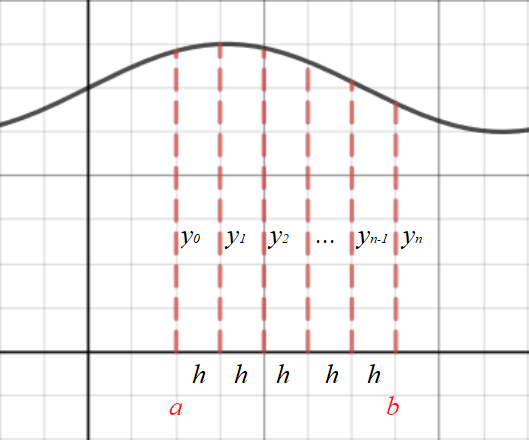9.4 The trapezium rule
The trapezium rule can be used to find the approximate area under a curve for functions which are impossible to integrate algebraically.
Consider the graph below of \(y=f(x)\).

The area under the curve from \(x=a\) to \(x=b\) can be split into \(n\) strips (trapeziums).
The sum of the areas of the trapeziums is an approximation of the area under the curve, i.e. \(\displaystyle\int_a^b{y} dx \).
The width of each strip (\(h\)) is calculated by \(h = \dfrac{b-a}{n}\).
The height of the boundary of each strip can be calculated by working out \(y_0 = f(a)\), \(y_1 = f(a+h)\), \(y_2 = f(a+2h)\), etc
The area of one strip can be calculated by using the formula for the area of a trapezium, e.g. for the first strip:
\(Area = \dfrac{1}{2}h(y_0+y_1) \)
The area of all the strips (an approximation of the area under the curve) is therefore:
\(\displaystyle\int_a^b{y} dx \approx \dfrac{1}{2}h(y_0+y_1) + \dfrac{1}{2}h(y_1+y_2) + ... + \dfrac{1}{2}h(y_{n-1}+y_n)\)
Factorising out \(\dfrac{1}{2}h\) gives:
\(\displaystyle\int_a^b{y} dx \approx \dfrac{1}{2}h(y_0 + y_1 + y_1 + y_2 + y_2 + ... + y_{n-1} + y_{n-1} + y_n)\)
\(\implies \boxed{\displaystyle\int_a^b{y} dx \approx \dfrac{1}{2}h(y_0 + 2(y_1 + y_2 + ... + y_{n-1}) + y_n)} \)
Tip: This formula is provided in the formula book but you need to know how to use it.
Consider the graph below of \(y=f(x)\).

The area under the curve from \(x=a\) to \(x=b\) can be split into \(n\) strips (trapeziums).
The sum of the areas of the trapeziums is an approximation of the area under the curve, i.e. \(\displaystyle\int_a^b{y} dx \).
The width of each strip (\(h\)) is calculated by \(h = \dfrac{b-a}{n}\).
The height of the boundary of each strip can be calculated by working out \(y_0 = f(a)\), \(y_1 = f(a+h)\), \(y_2 = f(a+2h)\), etc
The area of one strip can be calculated by using the formula for the area of a trapezium, e.g. for the first strip:
\(Area = \dfrac{1}{2}h(y_0+y_1) \)
The area of all the strips (an approximation of the area under the curve) is therefore:
\(\displaystyle\int_a^b{y} dx \approx \dfrac{1}{2}h(y_0+y_1) + \dfrac{1}{2}h(y_1+y_2) + ... + \dfrac{1}{2}h(y_{n-1}+y_n)\)
Factorising out \(\dfrac{1}{2}h\) gives:
\(\displaystyle\int_a^b{y} dx \approx \dfrac{1}{2}h(y_0 + y_1 + y_1 + y_2 + y_2 + ... + y_{n-1} + y_{n-1} + y_n)\)
\(\implies \boxed{\displaystyle\int_a^b{y} dx \approx \dfrac{1}{2}h(y_0 + 2(y_1 + y_2 + ... + y_{n-1}) + y_n)} \)
Tip: This formula is provided in the formula book but you need to know how to use it.
Important
The trapezium rule
\(\displaystyle\int_a^b{y} dx \approx \dfrac{1}{2}h(y_0 + 2(y_1 + y_2 + ... + y_{n-1}) + y_n) \)
where \(h = \dfrac{b-a}{n}\)
\(\displaystyle\int_a^b{y} dx \approx \dfrac{1}{2}h(y_0 + 2(y_1 + y_2 + ... + y_{n-1}) + y_n) \)
where \(h = \dfrac{b-a}{n}\)
3